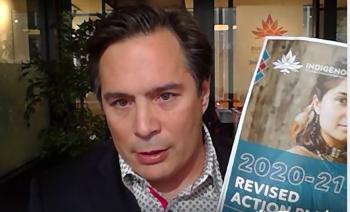Image Caption
Summary
Windspeaker.com Writer
A new stimulus investment fund that will see an injection of $25,000 each into as many as 640 Indigenous tourism businesses was announced March 24 by Keith Henry, president and CEO of the Indigenous Tourism Association of Canada (ITAC).
The application process will launch this Friday, he told viewers to his Facebook livestream yesterday, in which Tourism Minister Mélanie Joly took part. There will be a month-long intake of applications and then the resources will flow, Henry said. He promises it will be a simple application process.
Tourism is a major driver for the entire Canadian economy, worth over $100,000 billion, Henry said. It employs about 1.8 million people. There are roughly 40,000 people working in 1,900 businesses in Indigenous tourism.
“Our biggest challenge is making sure that the businesses don’t disappear. That they survive. That they don’t become insolvent.” Henry said he doesn’t expect to see a lot of tourism in the main activity period of May to October.
Both international and domestic tourism is going to be non-existent for some time, Henry said. Last year was a significant year of growth for Indigenous tourism. To see what has unfolded with COVID-19 has been “shocking.”
ITAC expects the initial roll-out of the stimulus funds will go to 140 businesses, and then will expand to over 600 by the third week of April.
“We are allocating all of the development grant money along with a large amount of savings from various line items. We will redirect all of these resources into this program, with or without our partners, so that we can provide a significant increase to the grants in order to help Indigenous entrepreneurs and their businesses stay afloat,” reads a press statement from ITAC.
“Indigenous tourism was booming before this was happening,” said Joly. “It was out-pacing all tourism sectors across the board across the country.”
She said the Indigenous tourism sector was the first to take the hit during the economic downturn caused by COVID-19, but she said the sector is resilient and expects it will be the first to bounce back, with a stimulus package that she will be working on for the time post-COVID-19.
In the face of the impacts of the pandemic, ITAC has rewritten its business action plan for 2020/21, release today at https://indigenoustourism.ca/corporate/reports/
The action plan speaks specifically to how ITAC will respond to COVID-19. Beyond the stimulus package, the plan will also focus on supporting the infrastructure built over recent years that helped grow the Indigenous tourism sector.
ITAC will invest in the stability of Indigenous tourism organizations, like Indigenous Tourism B.C., Indigenous Tourism Alberta and so on across the country.
“We decided to make that a priority because, the fact is, the reason why Indigenous tourism wasn’t growing that quickly from 2000 to 2014/15 was—and we assessed this quite thoroughly—there was a lack of coordination,” said Henry. “We don’t want to lose the infrastructure we’ve been building in the provinces and territories.”
The action plan will also ensure that ITAC itself remains stable. With 20 to 25 representatives working within the organization, ITAC wishes to maintain a certain level of operational know-how.
Joly provided a run-down of the stabilization package the government of Canada has initiated, including $10 billion more to Business Development Canada in lending capacity. She reminded people viewing the livestream that BDC has an Indigenous unit and she urged entrepreneurs to investigate BDC’s offerings.
Joly also outlined how the government has expanded the social safety net for people across the country. It provides Employment Insurance to those who don’t normally qualify and includes supports to the self-employed.
The Canada Child Benefit has been enhanced and government is working on tax measures for deferral of tax payments.
There is also a 10 per cent wage subsidy to a maximum of $25,000 per business.
The goal for the tourism sector itself is to ensure liquidity for businesses to survive the next weeks and months, said Joly. If you need cash rapidly, she advised business owners to “talk to your bank”. Financial institutions are now offering an expanded number of solutions.
While this is a time of stress and fear, said Henry, there will be a time beyond COVID-19, and he asked Joly what her vision was for the Indigenous tourism sector.
“I hope that we can use this crisis as a way to increase, much more, domestic tourism. I think we can have Canadians proud of being in a safe country that has a strong public health system that has people supporting each other.”
She said Canadians travel the most per capita in the world. “We love going to Florida and Mexico, but I think this is an opportunity to travel more of the country and support our tourism business, including obviously, Indigenous tourism.”
If you are a small Indigenous tourism business, but not yet a member of ITAC, Henry urges you to sign up. Membership is free. Go to https://indigenoustourism.ca/corporate/ to get on the organization’s email distribution list.

